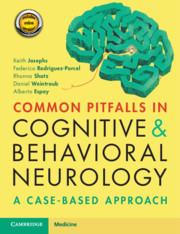Book contents
- Common Pitfalls in Cognitive and Behavioral Neurology
- Common Pitfalls in Cognitive and Behavioral Neurology
- Copyright page
- Dedication
- Contents
- Diseases Discussed in the Book
- Preface
- Acknowledgements
- Abbreviations
- Part 1 Missing the Diagnosis Altogether
- Part 2 Misidentifying the Impaired Cognitive Domain
- Part 3 Missing Important Clues in the History
- Part 4 Failure of Pattern Recognition
- Part 5 Difficult-to-Characterize Cognitive/Behavioral Disorders
- Part 6 Clinical Findings That Are Subtle
- Part 7 Misinterpreting Test Results
- Part 8 Attributing Findings to a Known or Suspected Disorder
- Part 9 Missing Radiographic Clues
- Case 41 Another Case of Vascular Cognitive Impairment?
- Case 42 Pseudoatrophic Pattern in Hydrocephalus
- Case 43 Parkinsonism, Ataxia, and Cognitive Impairment after Radiation Therapy
- Case 44 It’s Not Alzheimer Disease; Now What?
- Case 45 Getting the Full Picture
- Part 10 Management Misadventures
- Index
- Plate Section (PDF Only)
- References
Case 43 - Parkinsonism, Ataxia, and Cognitive Impairment after Radiation Therapy
from Part 9 - Missing Radiographic Clues
Published online by Cambridge University Press: 03 November 2020
- Common Pitfalls in Cognitive and Behavioral Neurology
- Common Pitfalls in Cognitive and Behavioral Neurology
- Copyright page
- Dedication
- Contents
- Diseases Discussed in the Book
- Preface
- Acknowledgements
- Abbreviations
- Part 1 Missing the Diagnosis Altogether
- Part 2 Misidentifying the Impaired Cognitive Domain
- Part 3 Missing Important Clues in the History
- Part 4 Failure of Pattern Recognition
- Part 5 Difficult-to-Characterize Cognitive/Behavioral Disorders
- Part 6 Clinical Findings That Are Subtle
- Part 7 Misinterpreting Test Results
- Part 8 Attributing Findings to a Known or Suspected Disorder
- Part 9 Missing Radiographic Clues
- Case 41 Another Case of Vascular Cognitive Impairment?
- Case 42 Pseudoatrophic Pattern in Hydrocephalus
- Case 43 Parkinsonism, Ataxia, and Cognitive Impairment after Radiation Therapy
- Case 44 It’s Not Alzheimer Disease; Now What?
- Case 45 Getting the Full Picture
- Part 10 Management Misadventures
- Index
- Plate Section (PDF Only)
- References
Summary
This 60-year-old woman presented with a 6-year history of bilateral hand tremor and progressive gait impairment. She first noticed bilateral hand tremor when holding objects, followed by balance impairment, slow walking with foot dragging, and a tendency to fall forward. Within four years, she required a wheelchair for ambulation. She endorsed initial short-term memory affecting her ability to process information, which accelerated in the last year. Two years prior to the onset of her symptoms she had received chemotherapy (carboplatin and etoposide) with prophylactic whole-brain radiation as treatment for lung cancer.
- Type
- Chapter
- Information
- Common Pitfalls in Cognitive and Behavioral NeurologyA Case-Based Approach, pp. 137 - 140Publisher: Cambridge University PressPrint publication year: 2020

